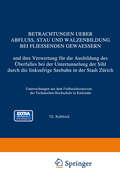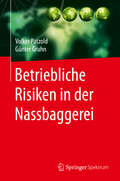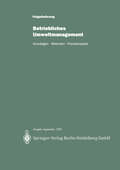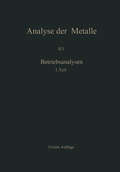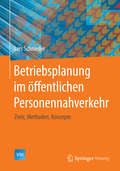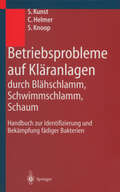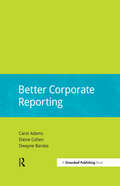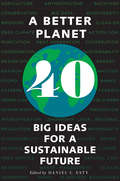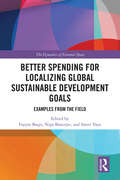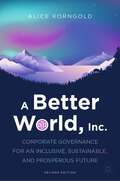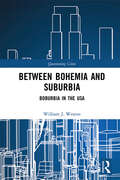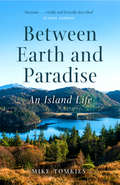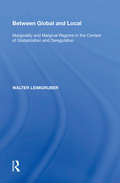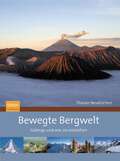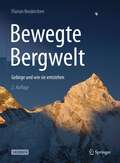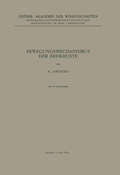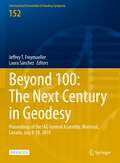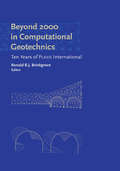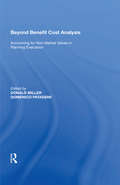- Table View
- List View
Betrachtungen Ueber Abfluss, Stau und Walzenbildung bei Fliessenden Gewaessern und ihre Verwertung für die Ausbildung des Überfalles bei der Untertunnelung der Sihl durch die linksufrige Seebahn in der Stadt Zürich: Untersuchungen aus dem Flußbaulaboratorium der Technischen Hochschule in Karlsruhe
by Th. RehbockDieser Buchtitel ist Teil des Digitalisierungsprojekts Springer Book Archives mit Publikationen, die seit den Anfängen des Verlags von 1842 erschienen sind. Der Verlag stellt mit diesem Archiv Quellen für die historische wie auch die disziplingeschichtliche Forschung zur Verfügung, die jeweils im historischen Kontext betrachtet werden müssen. Dieser Titel erschien in der Zeit vor 1945 und wird daher in seiner zeittypischen politisch-ideologischen Ausrichtung vom Verlag nicht beworben.
Betriebliche Risiken in der Nassbaggerei
by Volker Patzold Günter GruhnWie die in Nassbaggerei erfahrenen Autoren zeigen, ist der kapitalintensive Teil des Erdbaus im Nassen ein mitunter risikoreiches Geschäft. Die Risikohöhe wird vor allem durchoftmals große Mengenvordersätze,angetroffene Baugrundverhältnisse,ungenau beschriebene Hindernisse und Kontaminationen,klimatische Verhältnisse sowieungeeignete Gerätewahl bestimmt.Bei Aufstellung der Preiskalkulation wird immer wieder der eine oder andere Risikofaktor nicht oder nur ungenügend für einen angemessenen Preis berücksichtigt.Die wesentlichen Risikofaktoren für verschiedene Gerätetypen benennen Patzold und Gruhn und erläutern sie anhand von Lastfällen. Sie stellen in einer Modellrechnung einen Kostenvergleich auf und schätzen den zu erwartenden Schaden ab, indem sie Risiken auf Basis von Expertenwissen abschätzen. Je nach Gerätetyp kann bei Berücksichtigung dieser Risiken im betrachteten Modellfall ein bis zum 3,6-fachen höherer Einheitspreis erforderlich werden.Ziel des Buches ist es, mit der Nassbaggerei Beschäftigte bei deren Planung, Preisbildung und Durchführung zu sensibilisieren und die Hinnahme von Risiken zu minimieren.Dr.-Ing. Volker Patzold absolvierte 1968 ein Bergbaustudium an der TU Clausthal-Zellerfeld und wurde 1970 an der TU Hannover promoviert. Nach 2005 nahm er einem Lehrbeauftrag über Nassbaggerei an der TU Bergakademie Freiberg, Institut für Tagebau, wahr. Nach seinem Studium war er in verschiedenen Firmen im Bereich des Wasser-, Straßen- und Tiefbaus sowie des Tagebaus tätig. Seit 1984 ist er mit seinem Ingenieurbüro für Naßbaggerei und Tagebau auf Steine und Erden in Buchholz i. d. Nde. selbständig.Prof. Dr.-Ing. habil. Dr. h.c. Günter Gruhn studierte Maschinenbau in Dresden mit Fachausbildung auf dem Gebiet Energie- und Verfahrenstechnik, wurde 1963 an der TU Dresden promoviert und habilitierte sich 1966. Von 1968 bis 1993 war er Professor für Systemverfahrenstechnik an der TH Leuna-Merseburg und bis zu seiner Emeritierung im Jahre 2003 Leiter des Instituts für Prozess- und Anlagentechnik an der TU Hamburg-Harburg.
Betriebliches Umweltmanagement: Grundlagen - Methoden - Praxisbeispiele
by E. Hestermann-Beyerle A. Lindlar00.00 Einleitung (Stand: März '95) 00.02 Inhaltsübersicht (Stand: September '95) 00.03 Autorenverzeichnis (Stand: September '95) Inhaltsübersicht Anmerkungen zur effektiven Nutzung Die beste Information ist zu nichts nütze, wenn man sie nicht findet. Ausgehend von dieser Tatsache wurde das vorliegende Werk so gestaltet, daß es dem Leser möglichst leicht fällt, sich zu orientieren und spezielle Informationen schnell zu finden. Aufbau des Werkes »Betriebliches Umweltmanagement« ist aufgeteilt in sieben Sektionen, Sektionen mit jeweils mehreren Kapiteln. Eine Inhaltsübersicht Kapitel, Inhalts über die Sektionen und ihre Kapitel finden Sie auf den folgenden übersicht zwei Seiten. Darüber hinaus sind die Bezeichnungen der Sektionen auch auf dem farbig abgestuften Griffregister am rechten Buchrand sichtbar. Innerhalb eines Kapitels zeigen Ihnen die schwarzen Reiter am oberen Buchrand und die schwarzen Kapitelvermerke auf jeder Seite an, in welchem Kapitel welcher Sektion Sie sich befinden. Ein Inhaltsverzeichnis der einzelnen Sektionen finden Sie noch Inhalts einmal ganz am Anfang jeder Sektion (mit Datum der letzten verzeichnisse Aktualisierung). Für die spezielle Suche Wenn Sie eine ganz bestimmte Information suchen, werden Sie Stichwort das Stichwortregister sicher nützlich finden, das Sie im Kapitel register 99.05 finden. Die inhaltliche Gliederung der Kapitel ist aus den Stichwörtern Inhaltsübersicht des fett gedruckten Vorspanns zum jeweiligen Kapitel ersichtlich. und Zusammen Viele Kapitel bringen auf ihrer letzten Seite eine inhaltliche Zu fassungen der sammenfassung in kurzen Sätzen.
Betriebsplanung im öffentlichen Personennahverkehr: Ziele, Methoden, Konzepte (VDI-Buch)
by Lars SchniederMit diesem Buch erhält der Leser einen umfassenden Einblick in alle für die Planung, Durchführung und Kontrolle des Betriebs öffentlicher Personenverkehrssysteme (ÖPNV) relevanten Aufgaben. Eine besondere Beachtung finden hierbei verkehrsträgerspezifische Besonderheiten, da der Betrieb öffentlicher Personenverkehrssysteme unterschiedlichen Randbedingungen und einer großen Bandbreite einwirkender Störgrößen unterliegt. Die vergleichende Darstellung der Merkmale der Verkehrsträger sowie deren Auswirkung auf die Betriebsplanung fördert das Verständnis der planerischen Aufgaben. Das Buch "Betriebsplanung im öffentlichen Personennahverkehr" ist eine ganzheitliche und übersichtlich strukturierte Darstellung der einzelnen Planungsschritte in Verkehrsunternehmen in ihrem Zusammenhang. Vorhandene Methoden und Lösungsmöglichkeiten werden zusammengestellt und vergleichend diskutiert.Das Buch schließt die bestehende Lücke in der Fachliteratur. Es richtet sich an Angebotsplaner in Verkehrsverbünden, Betriebsplaner in Verkehrsunternehmen sowie planerisch tätigen Mitarbeitern in Ingenieurbüros. Studierende der Verkehrswissenschaften finden im vorliegenden Buch die für die beruflichen Aufgaben notwendige fachliche Vertiefung.
Betriebsprobleme auf Kläranlagen durch Blähschlamm, Schwimmschlamm, Schaum: Handbuch zur Identifizierung und Bekämpfung fädiger Bakterien
by S. Kunst C. Helmer S. KnoopStörungen im Betrieb der Kläranlagen zu erkennen und beseitigen zu können - das ist das Ziel dieser Veröffentlichung. Anhand sehr guter, überwiegend vierfarbiger Abbildungen werden Erscheinungsformen fädiger Bakterien erkennbar, die notwendigen mikroskopischen Untersuchungen werden durch ein vereinfachtes Bestimmungsschema erleichtert und angeleitet. Ausführliche Praxisbeispiele erläutern die Zusammenhänge und geben Hilfestellung und Ansatzpunkte bei Problemen. Dieses Handbuch gehört auf den Arbeitsplatz des Betriebsleiters von Kläranlagen.
Better Corporate Reporting
by Carol Adams Elaine Cohen Dwayne BarakaBetter Corporate Reporting outlines the latest frameworks for enhancing non-financial and sustainability reporting. It shows you how to integrate non-financial data into your reporting and overall strategy, creating long-term value, trust and transparency. It includes guides to: the International Integrated Reporting Council's new framework; the Global Reporting Initiative's G4 framework; and a detailed look at the concept at the heart of both of these new frameworks, materiality. It is the compilation of 3 bestselling sustainability guides on sustainability reporting.Understanding Integrated Reporting provides a practical and expert distillation of the new IR framework released by the International Integrated Reporting Council in December 2013. It explains what IR is and how to do it; how it links with other reporting frameworks and what it means in terms of thinking and processes. You'll also get a clear business case for IR and insights and best practice examples from leading integrated reporters. The Global Reporting Initiative (GRI) G4 Sustainability Reporting Framework was launched in May 2013. In Understanding G4, corporate reporting veteran Elaine Cohen presents an easy-to-follow review of everything any organization needs to know to decide whether to use the G4 Framework and if so, how. Materiality is the lynch-pin that can align your sustainability initiatives with your overall strategy. Making Sustainability Matter shows you how to identify your organization's most material sustainability issues, allocate resources to sustainability initiatives for optimal returns; connect your communications and reporting to materiality, and; clarify which issues are important to your stakeholders. Materiality is a core concept in both the GRI's new G4 framework the IIRC's new Integrated Reporting framework.
Better Corporate Reporting (Doshorts Ser.)
by Carol Adams Elaine Cohen Dwayne BarakaBetter Corporate Reporting outlines the latest frameworks for enhancing non-financial and sustainability reporting. It shows you how to integrate non-financial data into your reporting and overall strategy, creating long-term value, trust and transparency. It includes guides to: the International Integrated Reporting Council's new framework; the Global Reporting Initiative's G4 framework; and a detailed look at the concept at the heart of both of these new frameworks, materiality. It is the compilation of 3 bestselling sustainability guides on sustainability reporting.Understanding Integrated Reporting provides a practical and expert distillation of the new IR framework released by the International Integrated Reporting Council in December 2013. It explains what IR is and how to do it; how it links with other reporting frameworks and what it means in terms of thinking and processes. You'll also get a clear business case for IR and insights and best practice examples from leading integrated reporters. The Global Reporting Initiative (GRI) G4 Sustainability Reporting Framework was launched in May 2013. In Understanding G4, corporate reporting veteran Elaine Cohen presents an easy-to-follow review of everything any organization needs to know to decide whether to use the G4 Framework and if so, how. Materiality is the lynch-pin that can align your sustainability initiatives with your overall strategy. Making Sustainability Matter shows you how to identify your organization's most material sustainability issues, allocate resources to sustainability initiatives for optimal returns; connect your communications and reporting to materiality, and; clarify which issues are important to your stakeholders. Materiality is a core concept in both the GRI's new G4 framework the IIRC's new Integrated Reporting framework.
A Better Planet: Forty Big Ideas for a Sustainable Future
by Daniel C. Esty Ingrid C. BurkeA practical, bipartisan call to action from the world’s leading thinkers on the environment and sustainability Sustainability has emerged as a global priority over the past several years. The 2015 Paris Agreement on climate change and the adoption of the seventeen Sustainable Development Goals through the United Nations have highlighted the need to address critical challenges such as the buildup of greenhouse gases in the atmosphere, water shortages, and air pollution. But in the United States, partisan divides, regional disputes, and deep disagreements over core principles have made it nearly impossible to chart a course toward a sustainable future. This timely new book, edited by celebrated scholar Daniel C. Esty, offers fresh thinking and forward-looking solutions from environmental thought leaders across the political spectrum. The book’s forty essays cover such subjects as ecology, environmental justice, Big Data, public health, and climate change, all with an emphasis on sustainability. The book focuses on moving toward sustainability through actionable, bipartisan approaches based on rigorous analytical research.
Better Spending for Localizing Global Sustainable Development Goals: Examples from the Field (The Dynamics of Economic Space)
by Fayyaz Baqir Nipa Banerjee Sanni YayaThis book centers around an intense debate among donors, policymakers, development practitioners, and academics on the efficacy of aid in eradicating poverty while promoting human development. It seeks to fill the gap in present literature by presenting stories of better spending through implementing Sustainable Development Goals and addressing Agenda 2030 via indigenization of global development goals with initiatives at local and national levels. The book adopts an innovative approach to dealing with aid effectiveness by highlighting the relevance of better spending, rather than excessive spending. It does so with real-life examples of interventions made in the Global South to realize the vision of "thinking globally and acting locally". These case studies speak to the significance of communities’ role in shouldering responsibility for planning, financing, operating, and maintaining local developmental initiatives. The examples also demonstrate how aid serves its purpose when used as an investment in communities and enterprising individuals, in order to realize the strategic impact of giving and build a local "receiving mechanism" for indigenizing and achieving global development goals. The book references cases of better spending by governments, philanthropists, and civil society organizations (CSOs) from across Asia, Africa, and Latin America on a range of issues and will, thus, be of interest to development practitioners, policymakers, donors, philanthropists, civil society organizations, and academics and students of international development studies.
Better Spending for Localizing Global Sustainable Development Goals: Examples from the Field (The Dynamics of Economic Space)
This book centers around an intense debate among donors, policymakers, development practitioners, and academics on the efficacy of aid in eradicating poverty while promoting human development. It seeks to fill the gap in present literature by presenting stories of better spending through implementing Sustainable Development Goals and addressing Agenda 2030 via indigenization of global development goals with initiatives at local and national levels. The book adopts an innovative approach to dealing with aid effectiveness by highlighting the relevance of better spending, rather than excessive spending. It does so with real-life examples of interventions made in the Global South to realize the vision of "thinking globally and acting locally". These case studies speak to the significance of communities’ role in shouldering responsibility for planning, financing, operating, and maintaining local developmental initiatives. The examples also demonstrate how aid serves its purpose when used as an investment in communities and enterprising individuals, in order to realize the strategic impact of giving and build a local "receiving mechanism" for indigenizing and achieving global development goals. The book references cases of better spending by governments, philanthropists, and civil society organizations (CSOs) from across Asia, Africa, and Latin America on a range of issues and will, thus, be of interest to development practitioners, policymakers, donors, philanthropists, civil society organizations, and academics and students of international development studies.
A Better World, Inc.: Corporate Governance for an Inclusive, Sustainable, and Prosperous Future
by Alice KorngoldThe first edition of A Better World, Inc. showed how companies can profit by solving global problems. Increasingly, companies and investors are capitalizing on these opportunities. The three factors necessary for success were revealed to be effective corporate governance, stakeholder engagement, and collaboration. Racial equity and justice, and gender equity, were also themes in the original edition. By drawing on new research and case studies, this updated edition shows that inclusion and sustainability are in fact fundamental prerequisites for prosperity for companies and society. Specifically, racial inequity and injustice, and gender inequity, are systemic problems that impede businesses from achieving their greater potential in the global marketplace; in the meantime, society suffers as well. The second edition of A Better World, Inc. builds on the first by showing that companies have the power and incentives – and their boards of directors have the responsibility and the authority – to drive solutions to social, economic, and environmental challenges. Readers will learn how companies and their boards, together with nonprofits and governments, can drive prosperity by centering equity and sustainability.This edition is organized to address environmental, social, and governance practices, which are priority interests for investors, media, the public, government, and others to assess company practices and profitability.
Between Bohemia and Suburbia: Boburbia in the USA (Questioning Cities)
by William J. WestonThis book identifies a distinctive kind of urban neighborhood that is on the rise throughout the USA, the dense, walkable, mixed-use bourgeois-bohemian suburb or the "boburb." It looks at case studies of areas to live in Louisville, Kentucky. Based on scores of interviews with college graduates, backed by survey data and Census figures, it provides a clear, historical account of how these spaces arose. Chapters depict, analyze, and compare the Highlands neighborhood with other Louisville boburbs, contrasting them with the ephemeral bohemian quarters and the many suburban subdivisions. The Highlands are also compared with five other boburbs around the USA. Attention is given to the influence of transportation systems in shaping residential, community, and commercial spaces. Deeper cultural reasons for choosing the boburbs or the suburbs are also explored, including the political "big sort" between liberal and conservative places, and Bourdieu’s account of how the distinction between economic and cultural capital shapes how people choose to live where they live. This book will appeal to those interested in the evolution and distinctions among urban neighborhoods. It is ideal for academics and students within urban geography, urban gentrification, cities, and population.
Between Bohemia and Suburbia: Boburbia in the USA (Questioning Cities)
by William J. WestonThis book identifies a distinctive kind of urban neighborhood that is on the rise throughout the USA, the dense, walkable, mixed-use bourgeois-bohemian suburb or the "boburb." It looks at case studies of areas to live in Louisville, Kentucky. Based on scores of interviews with college graduates, backed by survey data and Census figures, it provides a clear, historical account of how these spaces arose. Chapters depict, analyze, and compare the Highlands neighborhood with other Louisville boburbs, contrasting them with the ephemeral bohemian quarters and the many suburban subdivisions. The Highlands are also compared with five other boburbs around the USA. Attention is given to the influence of transportation systems in shaping residential, community, and commercial spaces. Deeper cultural reasons for choosing the boburbs or the suburbs are also explored, including the political "big sort" between liberal and conservative places, and Bourdieu’s account of how the distinction between economic and cultural capital shapes how people choose to live where they live. This book will appeal to those interested in the evolution and distinctions among urban neighborhoods. It is ideal for academics and students within urban geography, urban gentrification, cities, and population.
Between Earth and Paradise: An Island Life
by Mike Tomkies‘His writings opened the eyes and changed the lives of others’ - HeraldAfter giving up a hectic life as a journalist in Europe and Hollywood in the late 1960s to return to his boyhood love of nature, Mike Tomkies moved to Eilean Shona, a remote island off the west coast of Scotland.There he rebuilt an abandoned croft house and began a new way of life observing nature. He tracked foxes and stags, made friends with seals and taught an injured sparrow-hawk to hunt for itself. It was the indomitable spirit of this tiny bird that taught Tomkies what it takes for any of us to be truly free. Whether he was fishing, growing his own food or battling through stormy seas in a tiny boat, he learned that he could survive in the harsh environment.This is the astonishing story of daring to take the first step away from urban routines and embracing a harsh yet immensely rewarding way of life which, in turn, led Tomkies to an even more remote location and inspired an acclaimed series of books on various animals and the challenges and joys of living in remote places.
Between Global and Local: Marginality and Marginal Regions in the Context of Globalization and Deregulation
by Walter LeimgruberThe definitions for 'marginality' and 'marginal regions' are vague and differ between academic disciplines. Marginal regions could however be characterized as regions lying off mainstream processes (in a sort of vacuum) both in society and economy, but also in relation to the natural environment and geographical remoteness. Illustrated by a wide range of international case studies, this book provides a complete overview of current research into marginality and examines a wide range of possible development options which could offer hope to marginal regions. It explores the background to various kinds of marginality, describes various types of marginal regions and discusses possible solutions for political, economic and socio-cultural actors to fight the ongoing processes of marginalization. Marginality and marginal regions are looked at from a wide perspective and are seen as being in part the outcome of globalization and deregulation. The book not only discusses practical policy options, but also considers marginality in its relation to ethics and spirituality.
Between Global and Local: Marginality and Marginal Regions in the Context of Globalization and Deregulation
by Walter LeimgruberThe definitions for 'marginality' and 'marginal regions' are vague and differ between academic disciplines. Marginal regions could however be characterized as regions lying off mainstream processes (in a sort of vacuum) both in society and economy, but also in relation to the natural environment and geographical remoteness. Illustrated by a wide range of international case studies, this book provides a complete overview of current research into marginality and examines a wide range of possible development options which could offer hope to marginal regions. It explores the background to various kinds of marginality, describes various types of marginal regions and discusses possible solutions for political, economic and socio-cultural actors to fight the ongoing processes of marginalization. Marginality and marginal regions are looked at from a wide perspective and are seen as being in part the outcome of globalization and deregulation. The book not only discusses practical policy options, but also considers marginality in its relation to ethics and spirituality.
Bewegte Bergwelt: Gebirge und wie sie entstehen
by Florian NeukirchenBerge können auf unterschiedliche Weise entstehen: durch Kollision und Einengung, aber erstaunlicherweise auch durch den gegenteiligen Vorgang, durch Dehnung. Andere finden sich wiederum fernab in Gebieten, in denen schon seit langer Zeit keine tektonischen Bewegungen stattfanden. Die Bergwelt, wie wir sie kennen, geht auf eine Vielzahl von Prozessen zurück, die von Florian Neukirchen auf leicht verständliche Weise erklärt werden: etwa Deckenüberschiebungen und das Verformen von Gesteinen. Manche Hochgebirge können – in geologischen Zeiträumen betrachtet - schnell aufsteigen und danach aber auch regelrecht wieder auseinanderfließen. In manchen Gebirgen begegnen uns erstaunliche Phänomene, die zum Teil erst in den letzten Jahrzehnten von Geologen verstanden wurden oder bis heute noch unverstanden sind. Da diese geologische Berg- und Talfahrt einige beliebte Reiseziele besucht und diese in faszinierenden Fotos vorstellt, ist sie zugleich eine Art Reiseführer für Naturfreunde.
Bewegte Bergwelt: Gebirge und wie sie entstehen
by Florian NeukirchenEine geologische Berg- und TalfahrtDie Bergwelt, wie wir sie kennen, geht auf eine Vielzahl von Prozessen zurück. Florian Neukirchen erklärt diese auf leicht verständliche Weise. Er führt in einer geologischen Berg- und Talfahrt durch alle Welt und fördert so manche Überraschung zutage. Ausgezeichnete Fotos begleiten den Text und wecken Reiselust. Da viele beliebte Reiseziele detailliert erklärt werden, ist das Buch zugleich eine Art Reiseführer für Naturfreunde. Warum sind die Berge so hoch, wie sie sind? Wie kommen Hochdruckgesteine an die Oberfläche? Wie entstehen Falten und Überschiebungen? Was passiert bei einem Vulkanausbruch? Warum gibt es in den Anden große Lücken im „Feuergürtel“? Warum gibt es Berge in Norwegen, in Neuseeland oder die Tepui in Venezuela? Wie beeinflussen sich Tektonik und Klima? Und woher wissen wir das alles? Diese und viele andere spannende Fragen werden beantwortet. Das Buch stützt sich dabei auf aktuelle Erkenntnisse aus so unterschiedlichen Fachgebieten wie Plattentektonik, Tektonik, Geomorphologie, Geophysik und Petrologie. Ein Buch, das Sie mitnimmt auf eine faszinierende Reise in Welten, die alles andere sind als fest und starr – eine sich bewegende Geschichte unserer Bergwelten mit vielen Höhen und Tiefen, die sich liest wie ein spannender Krimi.
Bewegungsmechanismus der Erdkruste (Denkschriften der Österreichischen Akademie der Wissenschaften #108 / 3)
by Wjatscheslaw JardetzkyBeyond 100: Proceedings of the IAG General Assembly, Montreal, Canada, July 8-18, 2019 (International Association of Geodesy Symposia #152)
by Jeffrey T. Freymueller Laura SánchezThis open access book contains 30 peer-reviewed papers based on presentations at the 27th General Assembly of the International Union of Geodesy and Geophysics (IUGG). The meeting was held from July 8 to 18, 2019 in Montreal, Canada, with the theme being the celebration of the centennial of the establishment of the IUGG. The centennial was also a good opportunity to look forward to the next century, as reflected in the title of this volume. The papers in this volume represent a cross-section of present activity in geodesy, and highlight the future directions in the field as we begin the second century of the IUGG. During the meeting, the International Association of Geodesy (IAG) organized one Union Symposium, 6 IAG Symposia, 7 Joint Symposia with other associations, and 20 business meetings. In addition, IAG co-sponsored 8 Union Symposia and 15 Joint Symposia. In total, 3952 participants registered, 437 of them with IAG priority. In total, there were 234 symposia and 18 Workshops with 4580 presentations, of which 469 were in IAG-associated symposia.
Beyond 2000 in Computational Geotechnics
by Ronald B. J. BrinkgreveThis volume contains papers presented during the first international PLAXIS symposium. Topics covered include: general geo-technical aspects; tunnels and deep excavations, and education and research. This pack is meant for the user of the PLAXIS program, as well as engineers and researchers.
Beyond 2000 in Computational Geotechnics
by Ronald B.J. BrinkgreveThis volume contains papers presented during the first international PLAXIS symposium. Topics covered include: general geo-technical aspects; tunnels and deep excavations, and education and research. This pack is meant for the user of the PLAXIS program, as well as engineers and researchers.
Beyond Benefit Cost Analysis: Accounting for Non-Market Values in Planning Evaluation
by Domenico Patassini Donald MillerIllustrated by case studies from Europe, North America and the Middle East, this book examines how non-market values can be identified, measured and incorporated into planning evaluation methodologies. The traditional means of assessing planning options, benefit-cost analysis, requires that all effects be expressed in monetary terms and this volume offers alternative approaches. It presents strategies for accomplishing the major purposes of planning evaluation - including the provision of an explicit, replicable basis for public assessment - in alternative ways. Growing demand for public involvement and for accountability in decision making requires better means for accommodating a broad range of concerns in planning evaluation. Methodologies examined include effectiveness-cost and multicriteria analysis, and the book explores how these have been applied in practice in developing special-issue plans, complex regional development strategies, and efforts to analyze the environmental justice implications of major infrastructure projects. Use of scenarios and problem structuring methods by stakeholder groups are also explored.
Beyond Benefit Cost Analysis: Accounting for Non-Market Values in Planning Evaluation
by Domenico Patassini Donald MillerIllustrated by case studies from Europe, North America and the Middle East, this book examines how non-market values can be identified, measured and incorporated into planning evaluation methodologies. The traditional means of assessing planning options, benefit-cost analysis, requires that all effects be expressed in monetary terms and this volume offers alternative approaches. It presents strategies for accomplishing the major purposes of planning evaluation - including the provision of an explicit, replicable basis for public assessment - in alternative ways. Growing demand for public involvement and for accountability in decision making requires better means for accommodating a broad range of concerns in planning evaluation. Methodologies examined include effectiveness-cost and multicriteria analysis, and the book explores how these have been applied in practice in developing special-issue plans, complex regional development strategies, and efforts to analyze the environmental justice implications of major infrastructure projects. Use of scenarios and problem structuring methods by stakeholder groups are also explored.
